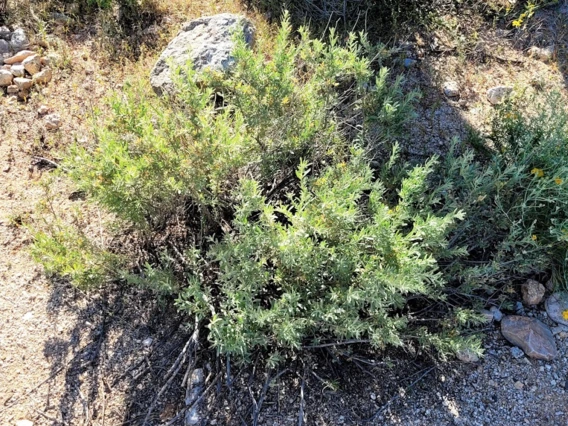Family: Amaranthaceae
Compound: Atr can
Synonyms: Obione berlandieri, Obione canescens, Obione tetraptera, Pterochiton occidentale
Geographic Origin: western US, northern MX
Characteristics: This plant hybridizes readily and also has some plasticity in expression of characteristics within a single plant. It is a usually long lived, woody, semi-evergreen, erect and rounded, informal shrub usually growing 0.9m (3ft) high and equally wide but can reach ~ 2.4m (8ft). Rigid and brittle stems are densely covered in silvery pubescence as are the roughly 2.5-5cm (1-2in) long narrow leaves. Trichomes of mature leaves accumulate salt on leaf surfaces. Leaves may be evergreen, or winter-deciduous in cold climates. This (mostly) dioecious wind-pollinated plant has tiny spikes of staminate flowers and pistillate flowers arranged on larger 3-15cm (1-6in) panicles. Flowers appear in early summer and fruits develop by July. Fruits are less than 3.8mm (0.15in) long with distinct square bracts (thus, the common name “four winged” salt bush). Seeds are orthodox and known to sprout after 10-20 years of storage and very likely survive in soil seed banks.
Natural History: Found in a variety of communities from below sea level to 2590m (8,500ft).
Cultivation Notes: Typically propagated by seed, though basal branch sprouts can sometimes root. Both physical and physiological seed dormancy is common so both scarification and stratification are required for germination. Remove “wings” from seeds and plant 1.3cm (0.5in) deep in fine soil or 2cm (0.75in) deep if direct sowing outdoors in coarse or gravelly soils. Seeds should be planted when temperatures are around 15C (low 60sF) and given water to start the germination process. This usually occurs between 7-21 days after sowing.
For general plant propagation information, click here
Ethnobotany: This species has many practical uses ranging from biological control of insects, erosion control, restoration of disturbed lands and livestock and human food source. Native Americans ground the seed for flower and used the leaves placed on coals to give a salty flavor to roasted food. The new growth produces a yellow dye used for textiles, and even the ashes of burned branches were added to blue corn dough to make green bread. The roots and flowers were ground to soothe insect bites. The roots were also used to treat coughs and toothaches. The plant is also commonly used in cultivation as a landscape ornamental. As such, there are several cultivars available including ‘Marana’, ‘Rincon’, ‘Santa Rita’ and ‘Wytana’.
Citations:
Kartesz, John Thomas. 1988. A flora of Nevada. Reno, NV: University of Nevada. 1729 p. [In 3 volumes]. Dissertation. [42426]
Hitchcock, C. Leo; Cronquist, Arthur. 1973. Flora of the Pacific Northwest. Seattle, WA: University of Washington Press. 730 p. [1168]
USDA Fire Effects Information System. Retrieved July 3, 2023
https://www.fs.usda.gov/database/feis/plants/shrub/atrcan/all.html#108
Stutz, Howard C.; Pope, C. Lorenzo; Leslie, Thomas. 1975. Germination studies in Atriplex. In: Stutz, Howard C., ed. Wildland Shrubs: Proceedings-- symposium and workshop: 1975
November 5-7; Provo, UT. Provo, UT: Brigham Young University: 150. [2289]
Barrow, Jerry R. 1997. Natural asexual reproduction in fourwing saltbrush Atriplex canescens (Pursh) Nutt. Journal of Arid Environments. 36(2): 267-270. [42451]
Vestal, Paul A. 1952. Ethnobotany of the Ramah Navaho. Reports of the Ramah Project: No. 4. Papers of the Peabody Museum of American Archeology and Ethnology: 40(4). Cambridge, MA: Harvard University. 94 p. [37064]
USDA Natural Resources Conservation Service. Retrieved July 3, 2023
https://plants.usda.gov/DocumentLibrary/plantguide/pdf/pg_atca2.pdf
Castetter, Edward F. 1935. Ethnobiological studies in the American Southwest. Biological Series No. 4: Volume 1. Albuquerque, NM: University of New Mexico. 62 p. [35938]
SEINet Arizona – New Mexico Chapter. Retrieved June 7, 2024.







